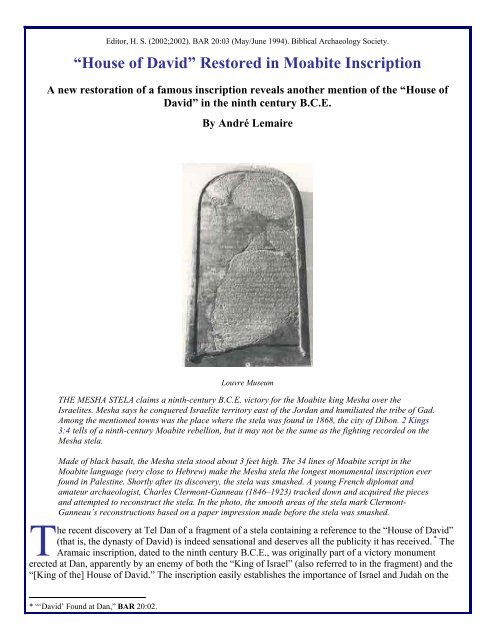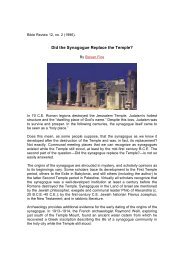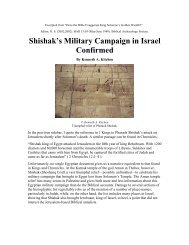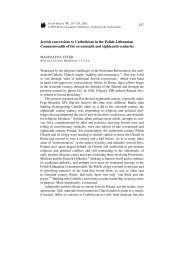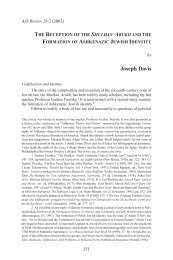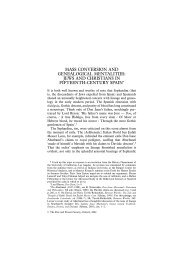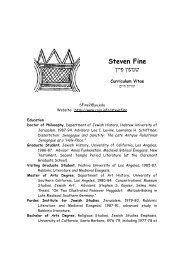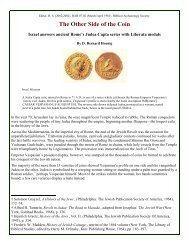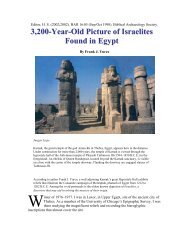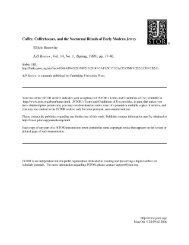“House of David” Restored in Moabite Inscription
“House of David” Restored in Moabite Inscription
“House of David” Restored in Moabite Inscription
You also want an ePaper? Increase the reach of your titles
YUMPU automatically turns print PDFs into web optimized ePapers that Google loves.
Editor, H. S. (2002;2002). BAR 20:03 (May/June 1994). Biblical Archaeology Society.<br />
<strong>“House</strong> <strong>of</strong> <strong>David”</strong> <strong>Restored</strong> <strong>in</strong> <strong>Moabite</strong> <strong>Inscription</strong><br />
A new restoration <strong>of</strong> a famous <strong>in</strong>scription reveals another mention <strong>of</strong> the <strong>“House</strong> <strong>of</strong><br />
<strong>David”</strong> <strong>in</strong> the n<strong>in</strong>th century B.C.E.<br />
By André Lemaire<br />
Louvre Museum<br />
THE MESHA STELA claims a n<strong>in</strong>th-century B.C.E. victory for the <strong>Moabite</strong> k<strong>in</strong>g Mesha over the<br />
Israelites. Mesha says he conquered Israelite territory east <strong>of</strong> the Jordan and humiliated the tribe <strong>of</strong> Gad.<br />
Among the mentioned towns was the place where the stela was found <strong>in</strong> 1868, the city <strong>of</strong> Dibon. 2 K<strong>in</strong>gs<br />
3:4 tells <strong>of</strong> a n<strong>in</strong>th-century <strong>Moabite</strong> rebellion, but it may not be the same as the fight<strong>in</strong>g recorded on the<br />
Mesha stela.<br />
Made <strong>of</strong> black basalt, the Mesha stela stood about 3 feet high. The 34 l<strong>in</strong>es <strong>of</strong> <strong>Moabite</strong> script <strong>in</strong> the<br />
<strong>Moabite</strong> language (very close to Hebrew) make the Mesha stela the longest monumental <strong>in</strong>scription ever<br />
found <strong>in</strong> Palest<strong>in</strong>e. Shortly after its discovery, the stela was smashed. A young French diplomat and<br />
amateur archaeologist, Charles Clermont-Ganneau (1846–1923) tracked down and acquired the pieces<br />
and attempted to reconstruct the stela. In the photo, the smooth areas <strong>of</strong> the stela mark Clermont-<br />
Ganneau’s<br />
reconstructions based on a paper impression made before the stela was smashed.<br />
he recent discovery at Tel Dan <strong>of</strong> a fragment <strong>of</strong> a stela conta<strong>in</strong><strong>in</strong>g a reference to the <strong>“House</strong> <strong>of</strong> <strong>David”</strong><br />
(that is, the dynasty <strong>of</strong> David) is <strong>in</strong>deed sensational and deserves all the publicity it has received. * T<br />
The<br />
Aramaic <strong>in</strong>scription, dated to the n<strong>in</strong>th century B.C.E., was orig<strong>in</strong>ally part <strong>of</strong> a victory monument<br />
erected at Dan, apparently by an enemy <strong>of</strong> both the “K<strong>in</strong>g <strong>of</strong> Israel” (also referred to <strong>in</strong> the fragment) and the<br />
“[K<strong>in</strong>g <strong>of</strong> the] House <strong>of</strong> David.” The <strong>in</strong>scription easily establishes the importance <strong>of</strong> Israel and Judah on the<br />
* “‘David’ Found at Dan,” BAR 20:02.
<strong>in</strong>ternational scene at this time—no doubt to the chagr<strong>in</strong> <strong>of</strong> those modern scholars who ma<strong>in</strong>ta<strong>in</strong> that noth<strong>in</strong>g <strong>in</strong><br />
the Bible before the Babylonian exile can lay claim to any historical accuracy.<br />
This fragment from the Tel Dan stela has been hailed because it conta<strong>in</strong>s the name “David,” supposedly for the<br />
first time <strong>in</strong> ancient Semitic epigraphy. But this claim is not true—or at least not quite true. I believe these same<br />
words—the <strong>“House</strong> <strong>of</strong> <strong>David”</strong>—appear(ed) on the famous <strong>Moabite</strong> <strong>in</strong>scription known as the Mesha stela, also<br />
from the n<strong>in</strong>th century B.C.E. While for most scholars the reference to the <strong>“House</strong> <strong>of</strong> <strong>David”</strong> on the Tel Dan<br />
fragment was quite unexpected, I must confess I was not surprised at all. I have been work<strong>in</strong>g on the Mesha<br />
stela for the past seven years, and I am now prepar<strong>in</strong>g a detailed edition <strong>of</strong> the text. Nearly two years before the<br />
discovery <strong>of</strong> the Tel Dan fragment, I concluded that the Mesha stela conta<strong>in</strong>s a reference to the <strong>“House</strong> <strong>of</strong><br />
David.” Now the Tel Dan fragment tends to support this conclusion.<br />
Discovered <strong>in</strong> 1868, the Mesha stela has been studied for a long time. S<strong>in</strong>ce 1875, it has been displayed <strong>in</strong> the<br />
Louvre (now called the Grand Louvre and completely refurbished and beautified). I realize the burden is on me<br />
to establish the appearance <strong>of</strong> the <strong>“House</strong> <strong>of</strong> <strong>David”</strong> on the Mesha stela, because, despite the extensive<br />
commentary this <strong>in</strong>scription has received for more than a century, until now no one has suggested that it<br />
conta<strong>in</strong>s a reference to the <strong>“House</strong> <strong>of</strong> David.”<br />
Even today, the Mesha stela rema<strong>in</strong>s the longest monumental <strong>in</strong>scription discovered anywhere <strong>in</strong> Palest<strong>in</strong>e—<br />
east or west <strong>of</strong> the Jordan. In many ways the Mesha stela is similar to the stela from which the Tel Dan<br />
fragment came. Both stelae are made <strong>of</strong> black basalt. Both are (or were) approximately three feet high and two<br />
feet wide. Both are written <strong>in</strong> an almost identical Semitic script—close to the script used by the<br />
contemporaneous Israelites. Both date to the n<strong>in</strong>th century B.C.E. Both were erected by enemies <strong>of</strong> Israel to<br />
commemorate their victory. Even the languages are connected—both are Northwest Semitic, <strong>Moabite</strong> <strong>in</strong> the<br />
case <strong>of</strong> the Mesha stela (it is <strong>of</strong>ten called the <strong>Moabite</strong> stela or <strong>Moabite</strong> stone) and Early Aramaic <strong>in</strong> the case <strong>of</strong><br />
the Tel Dan stela. Both also conta<strong>in</strong> specific references to the “K<strong>in</strong>g <strong>of</strong> Israel” ( melech yisrael ). And, as I shall<br />
show, both also conta<strong>in</strong> a specific reference to the <strong>“House</strong> <strong>of</strong> David.”<br />
The reason this reference to the <strong>“House</strong> <strong>of</strong> <strong>David”</strong> has never been noted before may well be due to the fact that<br />
the Mesha stela has never had a proper editio pr<strong>in</strong>ceps . That is what I am prepar<strong>in</strong>g, 125 years after the<br />
discovery <strong>of</strong> the Mesha stela. The reason it has never had this k<strong>in</strong>d <strong>of</strong> publication is due to a series <strong>of</strong><br />
misfortunes that have befallen it s<strong>in</strong>ce its discovery.<br />
The first westerner to see the Mesha stela was a medical missionary named F. A. Kle<strong>in</strong>, who lived <strong>in</strong> Jerusalem<br />
but who travelled widely on both sides <strong>of</strong> the Jordan, reliev<strong>in</strong>g pa<strong>in</strong> and w<strong>in</strong>n<strong>in</strong>g converts. In 1868, on one <strong>of</strong><br />
Kle<strong>in</strong>’s trips east <strong>of</strong> the Jordan, <strong>in</strong> ancient Moab, his Bedou<strong>in</strong> hosts showed him an <strong>in</strong>scribed stone among the<br />
ru<strong>in</strong>s <strong>of</strong> Dhiban, Biblical Dibon. Ly<strong>in</strong>g face up, the monumental tablet, rounded at the top and with a flat base<br />
and a raised frame on the top and sides, conta<strong>in</strong>ed 34 l<strong>in</strong>es <strong>of</strong> script. Kle<strong>in</strong> agreed to buy the stone for a hundred<br />
napoleons (about $400 at that time). However, the deal soon became enmeshed <strong>in</strong> the rivalries among Prussia<br />
(North Germany), France and England <strong>in</strong> the territories <strong>of</strong> the Ottoman Empire <strong>of</strong> the 19th century. †<br />
† See M. Patrick Graham, “The Discovery and Reconstruction <strong>of</strong> the Mesha <strong>Inscription</strong>,” <strong>in</strong> Studies <strong>in</strong> the Mesha <strong>Inscription</strong> and<br />
Moab , ed. J.A. Dearman, Archaeology and Biblical Studies 02 (Atlanta: Scholars Press, 1989), pp. 41–92; compare also Siegfried<br />
Horn, “The Discovery <strong>of</strong> the <strong>Moabite</strong> Stone,” <strong>in</strong> The Word <strong>of</strong> the Lord Shall Go Forth, Essays <strong>in</strong> Honor <strong>of</strong> D. N. Freedman , eds.<br />
Carol L. Meyers and M. O’Connor (W<strong>in</strong>ona Lake, IN: Eisenbrauns, 1983), pp. 497–505.
Discovery sites: <strong>“House</strong> <strong>of</strong> <strong>David”</strong> <strong>in</strong>scriptions from the n<strong>in</strong>th century B.C.E. have been found on stelae at<br />
Dhiban and Dan<br />
Hershel Shanks<br />
The ru<strong>in</strong>s <strong>of</strong> Dhiban (Biblical Dibon), <strong>in</strong> Jordan, where the Mesha stela was found <strong>in</strong><br />
1868.
Although Kle<strong>in</strong> was a French citizen—he was born <strong>in</strong> Strasbourg (Alsace)—he worked with German colleagues<br />
<strong>in</strong> the Anglican Christian Missionary Society. When he returned to Jerusalem, he reported the f<strong>in</strong>d to the North<br />
German consul He<strong>in</strong>rich Petermann, who then sought money from Berl<strong>in</strong> to acquire the stela for the Germans.<br />
Although the Germans tried to keep secret the discovery <strong>of</strong> the stone and their negotiations to acquire it, news<br />
<strong>in</strong>evitably leaked out. Both the British Capta<strong>in</strong> Charles Warren, work<strong>in</strong>g for the Palest<strong>in</strong>e Exploration Fund<br />
(PEF), and the Frenchman Charles Clermont-Ganneau, a young translator (dragoman) for the French consul <strong>of</strong><br />
Jerusalem and amateur archaeologist, soon learned <strong>of</strong> the sensational discovery. Warren decided to do noth<strong>in</strong>g,<br />
so as not to <strong>in</strong>terfere with the German negotiations. Not so Clermont-Ganneau. He first sent an Arab to look at<br />
the <strong>in</strong>scription, who came back with a crude draw<strong>in</strong>g <strong>of</strong> some <strong>of</strong> the letters, enough to assure Clermont-<br />
Ganneau <strong>of</strong> the <strong>in</strong>scription’s importance. Clermont-Ganneau next dispatched a man named Ya‘qub Karavaca to<br />
Dhiban to take a paper squeeze <strong>of</strong> the <strong>in</strong>scription.<br />
Rescuer <strong>of</strong> the stela. Charles Clermont-Ganneau located and purchased 38 fragments<br />
bear<strong>in</strong>g 613 <strong>of</strong> the <strong>in</strong>scription’s approximately 1,000 letters. In 1873, he presented the<br />
fragments to the Louvre. Clermont-Ganneau’s fragments and 19 additional pieces donated<br />
by others together constitute about two-thirds <strong>of</strong> the orig<strong>in</strong>al stela. Although he reconstructed<br />
the stela for the Louvre, Clermont-Ganneau never published the <strong>in</strong>scription <strong>in</strong> a def<strong>in</strong>itive<br />
edition. He later became a renowned Near Eastern scholar. His other accomplishments<br />
<strong>in</strong>clude the discovery <strong>of</strong> the Royal Steward <strong>in</strong>scription and the identification <strong>of</strong> the<br />
site <strong>of</strong><br />
Biblical Gezer.<br />
Despite what might be considered Clermont-Ganneau’s <strong>in</strong>discretion, <strong>in</strong> the end he provided a unique and<br />
<strong>in</strong>valuable aid to uncover<strong>in</strong>g the stela’s contents. The Bedou<strong>in</strong> allowed Karavaca to take a squeeze <strong>of</strong> the stone.<br />
A squeeze is made by plac<strong>in</strong>g a sheet <strong>of</strong> s<strong>of</strong>t, wet paper on the <strong>in</strong>scription and press<strong>in</strong>g the paper <strong>in</strong>to the<br />
<strong>in</strong>cisions. After the paper dries, it is peeled <strong>of</strong>f and conta<strong>in</strong>s a reverse replica <strong>of</strong> the <strong>in</strong>scription with the letters <strong>in</strong><br />
a raised form.<br />
While Karavaca was wait<strong>in</strong>g for his squeeze <strong>of</strong> the <strong>in</strong>scription to dry, a fight erupted among the Bedou<strong>in</strong>, and<br />
Karavaca with his two horsemen were forced to flee for their lives. One horseman was wounded <strong>in</strong> the leg by a<br />
spear. The second horseman, Sheikh Jamil, succeeded <strong>in</strong> snatch<strong>in</strong>g the still-wet paper from the stone, stuff<strong>in</strong>g<br />
the seven ripped pieces <strong>in</strong>to his robe pocket. In this condition, the seven pieces <strong>of</strong> the squeeze were presented to<br />
Clermont-Ganneau, who put them <strong>in</strong> front <strong>of</strong> a candle and sometimes the sun <strong>in</strong> an effort to decipher the letters.
Louvre Museum<br />
The squeeze, published here for the first time s<strong>in</strong>ce it was made <strong>in</strong> 1868/69, consists <strong>of</strong><br />
seven ripped pieces <strong>of</strong> paper, which once formed a s<strong>in</strong>gle sheet. Produced by plac<strong>in</strong>g wet<br />
paper over the <strong>in</strong>scription and press<strong>in</strong>g it <strong>in</strong>to the grooves <strong>of</strong> writ<strong>in</strong>g, the squeeze bears a<br />
high-relief, reversed replica <strong>of</strong> the <strong>in</strong>scription. (The photo is pr<strong>in</strong>ted <strong>in</strong> reverse so as to<br />
read correctly.) The damage occurred as Ya‘qub Karavaca, who made the squeeze on<br />
Clermont-Ganneau’s behalf, fled for his life from a fight among the Bedou<strong>in</strong> who claimed<br />
to own the stela. A man accompany<strong>in</strong>g Karavaca, Sheikh Jamil, saved the squeeze by<br />
snatch<strong>in</strong>g it <strong>of</strong>f the stone while still wet, but ripped it <strong>in</strong> the process. Because the Bedou<strong>in</strong><br />
subsequently smashed the stela, this squeeze provides the only record <strong>of</strong> the full<br />
<strong>in</strong>scription <strong>in</strong> its orig<strong>in</strong>al form.<br />
One <strong>of</strong> the damaged l<strong>in</strong>es has long posed an <strong>in</strong>trigu<strong>in</strong>g challenge to scholars. L<strong>in</strong>e 31 on<br />
the stela beg<strong>in</strong>s by say<strong>in</strong>g, “And as for Horonen, dwelt there … ,” but a break has<br />
partially obliterated the subject <strong>of</strong> the sentence. With the help <strong>of</strong> the squeeze, scholars<br />
had previously restored the broken subject <strong>of</strong> the sentence as bt[-]wd . Now, for the first<br />
time, Pr<strong>of</strong>essor Lemaire proposes to reconstruct the miss<strong>in</strong>g letter as d, yield<strong>in</strong>g bt[d]wd,<br />
<strong>“House</strong> <strong>of</strong> David,” referr<strong>in</strong>g to the k<strong>in</strong>g <strong>of</strong> Judah. This not only fits the context <strong>of</strong> the<br />
<strong>in</strong>scription, but the sentence structure parallels an earlier reference <strong>in</strong> the <strong>in</strong>scription to<br />
the “k<strong>in</strong>g <strong>of</strong> Israel.” In the Bible, <strong>“House</strong> <strong>of</strong> <strong>David”</strong> <strong>of</strong>ten refers to the k<strong>in</strong>g <strong>of</strong> Judah ( 2<br />
Samuel 7:26 ; 1 K<strong>in</strong>gs 2:24 , etc.).<br />
Lemaire’s restoration gives us another mention <strong>of</strong> the <strong>“House</strong> <strong>of</strong> <strong>David”</strong> <strong>in</strong> a n<strong>in</strong>thcentury<br />
B.C.E. Semitic <strong>in</strong>scription (the first, from Dan, appeared <strong>in</strong> the March/April 1994<br />
BAR ). Moreover, it improves our understand<strong>in</strong>g <strong>of</strong> the Mesha stela. Apparently, the<br />
latter portion <strong>of</strong> the <strong>in</strong>scription, now largely miss<strong>in</strong>g, described Mesha’s victory over<br />
Judahite forces occupy<strong>in</strong>g sites southeast <strong>of</strong> the Dead Sea, just as the early parts <strong>of</strong> the<br />
<strong>in</strong>scription describe his victory over Israelite forces <strong>in</strong> the north.
This squeeze rema<strong>in</strong> s the only evidence <strong>of</strong> the <strong>in</strong>scription <strong>in</strong> its orig<strong>in</strong>al condition. The German consul<br />
Petermann meanwhile cont<strong>in</strong>ued negotiations <strong>in</strong> an effort to purchase the stone. Unable to conclude a barga<strong>in</strong>,<br />
he turned for help to the Ottoman authorities, the nom<strong>in</strong>al rulers <strong>of</strong> what was essentially a no-man’s land. In late<br />
1869, Frederick III, Crown Pr<strong>in</strong>ce <strong>of</strong> Prussia, paid an <strong>of</strong>ficial visit to Jerusalem and <strong>in</strong> the political context <strong>of</strong><br />
this visit, the Turks were pleased to lend their assistance to the Germans try<strong>in</strong>g to buy the stone. This proved<br />
more <strong>of</strong> a h<strong>in</strong>drance than a help. The Bedou<strong>in</strong> hated the Ottoman pasha <strong>of</strong> Nablus and preferred to destroy the<br />
stone rather than comply with his wishes. This they did forthwith by heat<strong>in</strong>g the stone and then pour<strong>in</strong>g cold<br />
water on it. They then distributed the pieces among various Bedou<strong>in</strong> families. (The story that the Bedou<strong>in</strong> broke<br />
the stone because they thought it might conta<strong>in</strong> treasure <strong>in</strong>side is apocryphal. Likewise the story that they broke<br />
it because they thought the <strong>in</strong>dividual pieces could be sold for more than the <strong>in</strong>tact stone.)<br />
At this po<strong>in</strong>t, Clermont-Ganneau published the first announcement <strong>of</strong> the existence <strong>of</strong> the stela, <strong>in</strong> the February<br />
17, 1870, edition <strong>of</strong> the Revue de l’Instruction Publique . Petermann had left Jerusalem by then and the Prussian<br />
consulate gave up the matter. Clermont-Ganneau vigorously attempted to recover pieces <strong>of</strong> the stone and was<br />
soon helped by Warren. In the end, Clermont-Ganneau managed to acquire three large fragments and numerous<br />
smaller ones conta<strong>in</strong><strong>in</strong>g 613 letters out <strong>of</strong> a total <strong>of</strong> about a thousand. Warren and the PEF acquired 18<br />
fragments with a total <strong>of</strong> 56 characters. In 1873, Clermont-Ganneau gave his fragments to the Louvre, and, the<br />
follow<strong>in</strong>g year, the PEF also gave the Louvre Warren’s 18 fragments.<br />
Us<strong>in</strong>g all these fragments as well as the squeeze, Clermont-Ganneau was able to restore the Mesha stela to the<br />
condition <strong>in</strong> which it is now on exhibit. About two-thirds consists <strong>of</strong> orig<strong>in</strong>al fragments. The other third is<br />
plaster and has been restored based primarily on the squeeze.<br />
The publication <strong>of</strong> the stela was not as successful as its restoration, however. True, <strong>in</strong> 1870 Clermont-Ganneau<br />
published a facsimile with a translation and commentary † and then, <strong>in</strong> 1875, some revised read<strong>in</strong>gs and<br />
improvements. † But neither publication conta<strong>in</strong>ed a photograph <strong>of</strong> the stela itself or <strong>of</strong> the squeeze, so there was<br />
no way to check Clermont-Ganneau’s read<strong>in</strong>gs.<br />
Ten years later, two other scholars (R. Smend and A. Soc<strong>in</strong>) published a detailed study <strong>of</strong> the <strong>in</strong>scription, based<br />
on their exam<strong>in</strong>ation <strong>of</strong> the stone and the squeeze <strong>in</strong> the Louvre. † (For years, the squeeze hung <strong>in</strong> a glass case<br />
beside the reconstructed stela.) Because Clermont-Ganneau had not yet published his editio pr<strong>in</strong>ceps , the study<br />
by Smend and Soc<strong>in</strong> was considered a “pirate edition.” It was not very good anyway.<br />
In response to this “pirate edition,” Clermont-Ganneau announced that his own “def<strong>in</strong>itive edition … so long<br />
deferred … with reproductions meet<strong>in</strong>g the legitimate scientific requirements” † would soon be forthcom<strong>in</strong>g.<br />
But he never produced it, although he spent years thereafter as a pr<strong>of</strong>essor at the Sorbonne and the Collège de<br />
France.<br />
The reason for Clermont-Ganneau’s failure to publish this edition rema<strong>in</strong>s obscure. Probably he hoped to return<br />
to Dhiban and collect other fragments <strong>of</strong> the stela. † In any event, this famous stela has never received a proper<br />
editio pr<strong>in</strong>ceps . And the squeeze has never been published, although a number <strong>of</strong> studies based on an<br />
exam<strong>in</strong>ation <strong>of</strong> the stone and squeeze have appeared. †<br />
That the squeeze has never been published probably accounts for the fact that it is still possible to obta<strong>in</strong>, here<br />
and there, a better read<strong>in</strong>g (as well as an improved historical <strong>in</strong>terpretation <strong>of</strong> the text).<br />
† Charles Clermont-Ganneau, La stèle de Dhiban ou stèle de Mesa roi de Moab 896 av. J.-C., Lettres a M. le Cte de Vogue (Paris,<br />
1870), also <strong>in</strong> Revue Archéologique (1870), pp. 184–207, 357–386.<br />
† Clermont-Ganneau, “La Stèle de Mésa,” Revue critique (Sept. 11, 1875), pp. 166–174.<br />
† Die Inschrift des Königs Mesa von Moab für akademische Vorlesungen Herausgegeben (Freiburg im Brisgau, 1886).<br />
† Clermont-Ganneau, “La Stèle de Mésa, examen critique du texte,” Journal Asiatique 9 (8th series, 1887), p. 72.<br />
† Clermont-Ganneau, “La Stèle de Mésa, examen critique du texte,” pp. 110–111.<br />
† See, for <strong>in</strong>stance, K. G. A. Nordlander, Die Inschrift des Königs Mesa von Moab (Leipzig, 1896); R. Dussaud, Les monuments<br />
palest<strong>in</strong>iens et judaiques (Musee du Louvre) (Paris, 1912), pp. 4–20; D. Sidersky, La stèle de Mésha, <strong>in</strong>dex bibliographique (Paris,<br />
1920); H. Michaud, “Sur la pierre et l’argile,” Cahiers d’archéologie biblique 10 (1958), pp. 29–45.
That is what I propose for one <strong>of</strong> the most difficult l<strong>in</strong>es <strong>in</strong> the text, l<strong>in</strong>e 31. This l<strong>in</strong>e is badly broken; part <strong>of</strong> it<br />
is still on the stone and part has been reconstructed from the squeeze.<br />
After a careful study <strong>of</strong> the squeeze, Clermont-Ganneau proposed the follow<strong>in</strong>g uncerta<strong>in</strong> read<strong>in</strong>g at the end <strong>of</strong><br />
the l<strong>in</strong>e: b[--]wd ( וד -- ב ). † This tentative read<strong>in</strong>g was confirmed by a German scholar, Mark Lidzbarski, who<br />
tentatively identified traces after b as part <strong>of</strong> a t ( ת ). † After check<strong>in</strong>g the orig<strong>in</strong>al and the squeeze <strong>in</strong> the<br />
Louvre, still another scholar, R. Dussaud, † proposed to read bt[-]wd .<br />
My own exam<strong>in</strong>ation <strong>of</strong> the stone and the squeeze, which is now be<strong>in</strong>g restored and cleaned <strong>of</strong> accumulated<br />
dust, confirms that t follows the b . I would now, for the first time, reconstruct the miss<strong>in</strong>g letter as a d ( ד ).<br />
The result: bt[d]wd ( וד [ ד ] בת ), the <strong>“House</strong> <strong>of</strong> [D]avid!”<br />
The attentive reader will immediately notice that <strong>“House</strong>” is spelled bt , rather than byt , as <strong>in</strong> the Tel Dan<br />
<strong>in</strong>scription. But this is <strong>in</strong> fact no problem. In <strong>Moabite</strong> (the language <strong>of</strong> this <strong>in</strong>scription) it was apparently spelled<br />
both ways at this time. Indeed, <strong>in</strong> this very <strong>in</strong>scription it is spelled bt five times (<strong>in</strong> l<strong>in</strong>es 7, 23, 27 and 30<br />
[twice]) and only once (<strong>in</strong> l<strong>in</strong>e 25) byt . The y may have been an archaic spell<strong>in</strong>g or an optional consonant-usedas-a-vowel<br />
<strong>in</strong> an essentially consonantal script; this is what scholars call plene orthography (spell<strong>in</strong>g) as<br />
opposed to defective orthography. Rudimentary vowels like these ( w and h are other examples) are referred to<br />
as matres lectionis , the mothers <strong>of</strong> read<strong>in</strong>g.<br />
The term bt[d]wd is the subject <strong>of</strong> the sentence that beg<strong>in</strong>s earlier <strong>in</strong> l<strong>in</strong>e 31. Unlike English, the subject is not<br />
necessarily at the beg<strong>in</strong>n<strong>in</strong>g. The sentence beg<strong>in</strong>s, “And as for Horonen [a place], dwelt there … ” Then comes<br />
the subject. That what follows identifies who lives <strong>in</strong> Horonen is clear from parallel passages elsewhere <strong>in</strong> the<br />
<strong>in</strong>scription <strong>in</strong>volv<strong>in</strong>g Israel, the northern k<strong>in</strong>gdom, rather than Judah, the southern k<strong>in</strong>gdom that was ruled by<br />
the House <strong>of</strong> David. For example, <strong>in</strong> l<strong>in</strong>es 7–8, we read, “Omri [previously identified <strong>in</strong> l<strong>in</strong>es 4–5 as the k<strong>in</strong>g <strong>of</strong><br />
Israel] had taken possession <strong>of</strong> the land <strong>of</strong> Medeba, and he dwelt there … ” It is clear that bt[-]wd is probably a<br />
designation for a k<strong>in</strong>g. It appears that the only possible restoration is bt[d]wd , the <strong>“House</strong> <strong>of</strong> David,” just as the<br />
“k<strong>in</strong>g <strong>of</strong> Israel” ( mlk ysr’l ) is mentioned three times earlier. Moreover, referr<strong>in</strong>g to the k<strong>in</strong>g <strong>of</strong> Judah by<br />
reference to the <strong>“House</strong>” <strong>of</strong> David has several parallels <strong>in</strong> the Bible ( 2 Samuel 7:26 ; 1 K<strong>in</strong>gs 2:24 , etc.).<br />
This new read<strong>in</strong>g not only establishes another appearance <strong>of</strong> the House <strong>of</strong> David <strong>in</strong> an ancient Semitic<br />
<strong>in</strong>scription, it also helps us to understand better the historical context <strong>of</strong> the Mesha stela.<br />
The text <strong>of</strong> the stela is written <strong>in</strong> the first person by the k<strong>in</strong>g <strong>of</strong> Moab, Mesha, son <strong>of</strong> the <strong>Moabite</strong> god Kemosh.<br />
After the <strong>in</strong>troduction (l<strong>in</strong>es 1–4), Mesha describes how Moab had been oppressed first by “Omri, k<strong>in</strong>g <strong>of</strong><br />
Israel” and then by Omri’s son (which could mean his grandson or any descendant). But, <strong>in</strong> a series <strong>of</strong> military<br />
confrontations, Mesha is successful <strong>in</strong> throw<strong>in</strong>g <strong>of</strong>f Israelite dom<strong>in</strong>ation, even conquer<strong>in</strong>g parts <strong>of</strong> Israelite<br />
territory <strong>in</strong> Transjordan: “Israel has perished forever,” he claims.<br />
In the pr<strong>in</strong>cipal part <strong>of</strong> the <strong>in</strong>scription (l<strong>in</strong>es 5–31a), Mesha recounts the battles he has won—led by the <strong>Moabite</strong><br />
god Kemosh, Mesha is always victorious—and the cities he has built. All <strong>of</strong> the identifiable sites are north <strong>of</strong><br />
the Arnon River, the area east <strong>of</strong> the Jordan that was apparently controlled by the northern k<strong>in</strong>gdom <strong>of</strong> Israel. In<br />
Biblical terms, this was the territory <strong>of</strong> the tribes <strong>of</strong> Gad and Reuben. The Mesha stela confirms (l<strong>in</strong>e 10) that<br />
“the men <strong>of</strong> Gad had dwelt [there] from <strong>of</strong> old.” Accord<strong>in</strong>g to the Mesha stela, Mesha was even successful <strong>in</strong><br />
captur<strong>in</strong>g the vessels <strong>of</strong> the Israelite God Yahweh (spelled just as it is <strong>in</strong> the Hebrew Bible)—this is the earliest<br />
mention <strong>of</strong> Yahweh <strong>in</strong> any known text or <strong>in</strong>scription.<br />
A quite different account <strong>of</strong> the “<strong>Moabite</strong> rebellion” is given <strong>in</strong> the Bible ( 2 K<strong>in</strong>gs 3:4–27 ). There Mesha’s<br />
rebellion is successfully repressed, although <strong>in</strong> a heart-rend<strong>in</strong>g episode Mesha sacrifices his own son on the wall<br />
<strong>of</strong> his capital to implore Kemosh for aid; follow<strong>in</strong>g this, the Israelites withdraw ( 2 K<strong>in</strong>gs 3:26–27 ). Mesha,<br />
† Clermont-Ganneau, “La Stèle de Mésa,” p. 173; and “La Stèle de Mésa, examen critique du texte,” p. 107.<br />
† Mark Lidzbarski, “E<strong>in</strong>e Nachprüfung der Mesa<strong>in</strong>schrift,” <strong>in</strong> Ephemeris für semitische Epigraphik I (Giessen, 1900), pp. 1–10.<br />
† Dussaud, Les monuments palest<strong>in</strong>iens et judaiques p. 5 ; compare also D. Sidersky, La stèle de Mésha, p. 11; A.H. Van Zyl, The<br />
<strong>Moabite</strong>s (Leiden: E.J. Brill, 1960), Addendum I.
although badly beaten, is thus able to ma<strong>in</strong>ta<strong>in</strong> his <strong>in</strong>dependence. The relation between the Biblical account<br />
mention<strong>in</strong>g Mesha ( 2 K<strong>in</strong>gs 3 ) and the conquests <strong>of</strong> Mesha <strong>in</strong> his stela (l<strong>in</strong>es 7–21) is not evident. Most<br />
commentators th<strong>in</strong>k they are two different ways <strong>of</strong> describ<strong>in</strong>g the same military campaign soon after the death<br />
<strong>of</strong> Ahab, k<strong>in</strong>g <strong>of</strong> Israel (c. 853 B.C.E.). It is more likely, however, that Mesha’s conquests over Israel date later,<br />
dur<strong>in</strong>g the reign <strong>of</strong> K<strong>in</strong>g Jehoahaz (c. 819–803 B.C.E.).<br />
Beg<strong>in</strong>n<strong>in</strong>g <strong>in</strong> l<strong>in</strong>e 31b <strong>of</strong> the stela, a new subject is <strong>in</strong>troduced, as Clermont-Ganneau already guessed long ago.<br />
† The language follows the same pattern as was used <strong>in</strong> the description <strong>of</strong> Moab’s military confrontations with<br />
Israel: “And as for Horonen, dwelt there [xxxxxx] … ” This is followed, as above, by Kemosh’s <strong>in</strong>struction to<br />
Mesha to go and fight aga<strong>in</strong>st Horonen. Horonen, however, is the first site south <strong>of</strong> the Arnon; it is located<br />
southeast <strong>of</strong> the Dead Sea. Aga<strong>in</strong> Mesha takes up arms and is aga<strong>in</strong> victorious. Then the <strong>in</strong>scription breaks <strong>of</strong>f;<br />
the rest is miss<strong>in</strong>g. As much as half <strong>of</strong> the <strong>in</strong>scription may have been destroyed.<br />
Enough has been preserved at the end <strong>of</strong> l<strong>in</strong>e 31, however, to identify the new enemy <strong>of</strong> Moab aga<strong>in</strong>st whom<br />
Mesha fought <strong>in</strong> the last half <strong>of</strong> the <strong>in</strong>scription: bt[d]wd , the House <strong>of</strong> David. Hav<strong>in</strong>g described how he was<br />
victorious aga<strong>in</strong>st Israel <strong>in</strong> the area controlled by it north <strong>of</strong> the Arnon, Mesha now turns to part <strong>of</strong> the area<br />
south <strong>of</strong> the Arnon which had been occupied by Judah, the House <strong>of</strong> David. * In the tenth and first half <strong>of</strong> the<br />
n<strong>in</strong>th centuries B.C.E., the k<strong>in</strong>gdom <strong>of</strong> Edom did not yet exist. The area southeast <strong>of</strong> the Dead Sea was<br />
apparently controlled by Judah. Thus, dur<strong>in</strong>g Mesha’s rebellion aga<strong>in</strong>st the k<strong>in</strong>g <strong>of</strong> Israel ( 2 K<strong>in</strong>gs 3:5 ), the<br />
k<strong>in</strong>g <strong>of</strong> Israel asks for assistance from the k<strong>in</strong>g <strong>of</strong> Judah, who agrees to provide the aid. The k<strong>in</strong>g <strong>of</strong> Israel<br />
<strong>in</strong>structs the k<strong>in</strong>g <strong>of</strong> Judah to attack the k<strong>in</strong>g <strong>of</strong> Moab by go<strong>in</strong>g through the “wilderness <strong>of</strong> Edom” ( 2 K<strong>in</strong>gs 3:8<br />
) because apparently it was an area controlled by the k<strong>in</strong>gdom <strong>of</strong> Judah. No doubt the miss<strong>in</strong>g part <strong>of</strong> the<br />
<strong>in</strong>scription described how Mesha also threw <strong>of</strong>f the yoke <strong>of</strong> Judah and conquered the territory southeast <strong>of</strong> the<br />
Dead Sea controlled by the House <strong>of</strong> David.<br />
In its way, the new fragmentary stela from Tel Dan helps to confirm this read<strong>in</strong>g <strong>of</strong> the Mesha stela. At Tel<br />
Dan, as <strong>in</strong> the Mesha stela, an adversary <strong>of</strong> the k<strong>in</strong>g <strong>of</strong> Israel and <strong>of</strong> the House <strong>of</strong> David describes on a stone<br />
monument his victories over Israel and the House <strong>of</strong> David, Judah.<br />
Indeed, both <strong>in</strong>scriptions may reflect more or less the same historical context. While the excavator <strong>of</strong> the Tel<br />
Dan <strong>in</strong>scription, Avraham Biran, dates it to the first half <strong>of</strong> the n<strong>in</strong>th century B.C.E., I would date it, on both<br />
paleographical and historical grounds, to the last quarter <strong>of</strong> the n<strong>in</strong>th century B.C.E., the same as the date <strong>of</strong> the<br />
Mesha stela. But that is another story … †<br />
† Clermont-Ganneau, “La Stèle de Mésa, examen critique du texte,” p. 112.<br />
* Incidentally, this supports a conclusion I reached several years ago that the territory <strong>of</strong> Edom was organized as a k<strong>in</strong>gdom only <strong>in</strong><br />
about 846 B.C.E., as <strong>in</strong>dicated by 1 K<strong>in</strong>gs 22:48 (“There was no k<strong>in</strong>g <strong>in</strong> Edom”) and 2 K<strong>in</strong>gs 8:20 (“Edom revolted aga<strong>in</strong>st Judah and<br />
set up its own k<strong>in</strong>g”) (“Hadad l’Edomite ou Hadad l’Araméen?” Biblische Notizen 43 (1988), pp. 14–18; “Les territoires d’Ammon,<br />
Moab et Edom dans la deuxieme moitié du IXe s. av. n. è.,” <strong>in</strong> Studies <strong>in</strong> the History and Archaeology <strong>of</strong> Jordan IV , ed. S. Tell<br />
(Amman, Jordan, 1992), pp. 209–214).<br />
† André Lemaire, “Epigraphie palest<strong>in</strong>ienne: nouveaux documents I. Fragment de stèle araméenne de Tell Dan (IXe s. av. J.-C.),”<br />
forthcom<strong>in</strong>g <strong>in</strong> Henoch 16 (1994).
A New Read<strong>in</strong>g: Translation <strong>of</strong> the Mesha Stela<br />
The 34 l<strong>in</strong>es <strong>of</strong> the text have been numbered for convenience <strong>in</strong> the follow<strong>in</strong>g translation by André Lemaire.<br />
Bracketed words and letters represent restorations <strong>of</strong> the text. Italicized words are uncerta<strong>in</strong>. The dots between<br />
brackets <strong>in</strong>dicate places where text is miss<strong>in</strong>g. The parenthetical word has been added for clarity but does not<br />
appear <strong>in</strong> the orig<strong>in</strong>al text.<br />
1. I am Mesha, son <strong>of</strong> Kemosh[ît], k<strong>in</strong>g <strong>of</strong> Mesha, the<br />
2. Dibonite. My father ruled over Moab for 30 years, and I ruled<br />
3. after my father. I made this high place for Kamosh <strong>in</strong> Qerihô, high pla[ce <strong>of</strong> the Sa]<br />
4. vior, for he saved me from all the k<strong>in</strong>gs and let me enjoy the sight <strong>of</strong> all my enemies. Omri<br />
5. (was) k<strong>in</strong>g <strong>of</strong> Israel, and he oppressed Moab many days, for Kamosh was angry with his<br />
6. land. And his son succeeded him, and he too said: “I will oppress Moab.” In my days, he said so,<br />
7. but I enjoyed his sight and that <strong>of</strong> his house. And Israel perished utterly forever. And Omri had taken<br />
possession <strong>of</strong> the land <strong>of</strong><br />
8. Medeba. And he dwelt <strong>in</strong> it <strong>in</strong> his days and the sum <strong>of</strong> the days <strong>of</strong> his sons: 40 years; but Kamosh<br />
9. restored it <strong>in</strong> my days. And I built Baal-meon, and I made a reservoir <strong>in</strong> it; and I built<br />
10. Qiryatên. And the men <strong>of</strong> Gad had dwelt <strong>in</strong> the land <strong>of</strong> Atarot from <strong>of</strong> old, and the k<strong>in</strong>g <strong>of</strong> Israel built<br />
11. Atarot for himself; but I fought aga<strong>in</strong>st the town and took it, and I slew all the people:<br />
12. the town belonged to Kamosh and to Moab. And I brought thence the altar-hearth <strong>of</strong> his Beloved , and I<br />
dragged<br />
13. it before Kamosh <strong>in</strong> Qirat/my town . And I settled <strong>in</strong> it the men <strong>of</strong> Sharon and the men <strong>of</strong><br />
14. Maharat. And Kamosh said to me: “Go! Take Nebo aga<strong>in</strong>st Israel.” And I<br />
15. went by night and fought aga<strong>in</strong>st it from break <strong>of</strong> dawn till noon. And I<br />
16. took it and slew all: 7,000 men, boys, women, girls,<br />
17. and pregnant women, because I had devoted it to Ashtar-Kamosh. And I took thence the altar-<br />
18. hearths <strong>of</strong> YHWH, and I dragged them before Kamosh. And the K<strong>in</strong>g <strong>of</strong> Israel had built<br />
19. Yahaz, and dwelt there<strong>in</strong> while he fought aga<strong>in</strong>st me; but Kamosh drove him out before me, and<br />
20. I took from Moab two hundred men, all the chiefs there<strong>of</strong>, and I established them <strong>in</strong> Yahaz; and I took it<br />
21. to add it to Dîbon. I built Qerihô: the wall <strong>of</strong> the parkland and the wall<br />
22. <strong>of</strong> the acropolis; and I built its gates, and I built its towers; and<br />
23. I built the k<strong>in</strong>g’s house; and I made banks for the water reservoir <strong>in</strong>side<br />
24. the town; and there was no cistern <strong>in</strong>side the town, <strong>in</strong> Qerihô, and I said to all the people: “Make yourself<br />
25. each a cistern <strong>in</strong> his house”; and I dug the ditches for Qerihô with prisoners<br />
26. <strong>of</strong> Israel. I built Aroer, and I made the highway through the Arnon.<br />
27. I built Bet-bamot, for it was destroyed; and I built Bezer, for it was <strong>in</strong> ru<strong>in</strong>s.<br />
28. [ And ] the men <strong>of</strong> Dîbon were fitted out for war because all Dîbon was obedient. And I ruled<br />
29. [ over a ] hundred <strong>of</strong> towns that I added to the land. And I built<br />
30. [the temple <strong>of</strong> Made]ba and the temple <strong>of</strong> Diblaten and the temple <strong>of</strong> Baal-meon; and I established there<br />
31. [……………] the sheep <strong>of</strong> the land. And the house [<strong>of</strong> Da]vid dwelt <strong>in</strong> Horonên<br />
32. [……………] and Kamosh said to me: “Go down! Fight aga<strong>in</strong>st Horonen.” And I went down, and [I<br />
33. [ I fought aga<strong>in</strong>st the town, and I took it; and ] Kamosh [resto]red it <strong>in</strong> my days. And I took up thence ten<br />
34. [……………………]…… And I[……
The Key Phrases: Can You See the Letters?<br />
The key phrases on the Mesha stela are highlighted <strong>in</strong> these photographic details and on the draw<strong>in</strong>g <strong>of</strong><br />
the text (above). “K<strong>in</strong>g <strong>of</strong> Israel” ( mlk ysr’l ) appears <strong>in</strong> l<strong>in</strong>e 5 and <strong>in</strong> two other places on the stela.<br />
<strong>“House</strong> <strong>of</strong> <strong>David”</strong> ( bt[d]wd ) appears <strong>in</strong> l<strong>in</strong>e 31 (photos below). The top photo focuses on the critical<br />
letters <strong>of</strong> l<strong>in</strong>e 31. The small draw<strong>in</strong>g shows the read<strong>in</strong>g, from right to left, <strong>of</strong> the letters bt wd (the dotted<br />
l<strong>in</strong>es represent restorations <strong>of</strong> damaged areas). In the bottom photo, a t<strong>in</strong>t highlights the letters as they<br />
appear on the stela. The t eluded scholars until the German scholar Mark Lidzbarski tentatively<br />
identified it <strong>in</strong> 1900. Pr<strong>of</strong>essor Lemaire has confirmed the read<strong>in</strong>g <strong>of</strong> the t and has restored the miss<strong>in</strong>g d<br />
on the basis <strong>of</strong> the squeeze and the sense <strong>of</strong> the text. (The draw<strong>in</strong>g at top, produced by Lidzbarski, has<br />
been corrected by Pr<strong>of</strong>essor Lemaire.)<br />
Lidzbarski, corrected by André Lemaire<br />
Draw<strong>in</strong>g <strong>of</strong> the Mesha stela. The critical letters <strong>in</strong> l<strong>in</strong>es 5 and 31 are highlighted <strong>in</strong> white.
Detail <strong>of</strong> the Mesha stela. The critical letters <strong>in</strong> l<strong>in</strong>e 5 are highlighted.<br />
Photos: Louvre Museum<br />
The top photo focuses on the critical letters <strong>of</strong> l<strong>in</strong>e 31. The small draw<strong>in</strong>g shows the read<strong>in</strong>g, from right to left, <strong>of</strong><br />
the letters bt wd (the dotted l<strong>in</strong>es represent restorations <strong>of</strong> damaged areas). In the bottom photo, a t<strong>in</strong>t highlights<br />
the letters as they appear on the stela.


